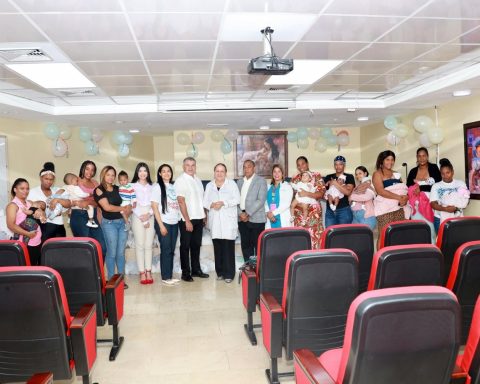Argentina is experiencing the steepest decline in births in its history with a fertility rate that fell by 34% between 2014 and 2020which meant an average of 250,000 fewer births each year, largely explained by the fact that there are 55% fewer adolescent pregnancies, which is why specialists say that the country is facing the opportunity of a “demographic bonus” to maximize resources and apply redistributive policies.
in the report “Demographic Odyssey. Demographic trends in Argentina: key inputs for the design of social welfare”prepared by CIPPEC, showed how, starting in 2014, fertility levels, that is, the number of children that pregnant people of childbearing age have, began to decrease “abruptly and significantly” as never before in history. records.
“34% fewer boys are born than were born five years ago. It is historic, it is totally revolutionary, it has never happened in history,” Rafael Rofman, a demographer and economist who worked at the World Bank, told Télam, and assured that “Before, about 750,000 children were born per year and now 500,000 are born,” according to data from Renaper and Anses that the professional reviewed.
Rofman specified that The number of children born per pregnant person is today “among the lowest in Latin America” and exemplified that “in 1950 the rate was 3.3 children per woman; between 1950 and 2010 it dropped to 2.4, while since 2015 it began to drop faster and faster and in 2020 we are at 1.55”.
One of the data that explains this marked decline in the number of births in Argentina in recent years is the accelerated drop of 55% of adolescent pregnancies.

The fall in those under 20 years of age
“In 2019 the general pregnancy rate in children under 20 years of age was 40.7% out of 1,000 births, and in 2020 it dropped to 30.3%. This has been maintained and is explained, as a preliminary hypothesis, by the application of the ENIA Plan for the prevention of unintentional pregnancy, with more availability of equipment and contraceptive methods, especially in the NOA and NEA regions, which were the ones with the highest rate,” Valeria Isla, national director of Health, told Télam. Sexual and Reproductive (SSR).
“This is good news because it creates conditions at the macro level for a different dynamic of economic development, the most successful countries are those with fewer children, because this allows more women to contribute to the economy of a country. There are more women who decide their future with more opportunities,” said Rofmanwho a few weeks ago gave a TEDx talk on this topic.
“The laws of voluntary interruption of pregnancy and comprehensive sexual education came to contribute a lot, since the same boys and girls have taken them as a banner”Valeria Island
The specialists explained that the possible drivers of this trend of fewer births in Argentina have to do with the increased accessibility to modern contraceptive technologiessuch as the subdermal implant, and the changes in social and cultural preferences and behaviors resulting from the rise of current feminist movements.
“The decision to have children is very particular, it is made beyond the economic situation. The reality is that it has much more to do with an autonomous dynamic of society. It’s a cultural issue, difficult to encompass,” Rofman said.
For Isla, “throughout the process of the green tide and the feminist movements, bodily autonomy has been able to be installed, moving away from the maternal-infant model as the only destination for women.”
“The laws for the voluntary interruption of pregnancy and comprehensive sexual education came to contribute a lot, since the same boys and girls have taken them as a banner,” Isla said.
In this sense, the director of SSR valued “the advancement of adolescent health programs and the incorporation of long-term methods in the general basket of sexual and reproductive health”including penile condoms, combination pills, single-hormone pills, injectable contraceptives, intrauterine device (IUD), emergency hormonal contraception (HEC), subdermal implants, and the surgical procedures of tubal ligation and vasectomy.
Teenage pregnancies decreased by 55% between 2015 and 2020
Teenage pregnancies decreased by 55% between 2015 and 2020, which meant that the number of pregnant people up to 20 years of age who had sons and daughters fell by an average of 60,000 each year, and specialists attribute this to the massive delivery of long-lasting contraceptive methods, sexual education and the social and cultural changes produced by feminisms.
Argentina is undergoing the steepest decline in births in its history, with a fertility rate that dropped 34% between 2014 and 2020, largely due to the fact that there have been 55% fewer adolescent pregnancies in recent years.
“Fertility dropped at all ages, but it dropped especially in those under 20. Low fertility tells you socially that we are in a society that is evolving very well in terms of recognition of women’s rights, the right to to choose”Rafael Rofman, a demographer and economist who prepared the report “Demographic Odyssey. Demographic trends in Argentina: key inputs for the design of social welfare,” assured Télam.
“And it also has to do with the availability of quality contraceptive methods, the trigger was that in 2014 subdermal implants began to be distributed, which are safe and very effective,” he added.
For Rofman, the drop in teen pregnancies “is very good news because of the cause, because they are girls who control their lives, their bodies, and have opportunities. And because of the consequences, because the vast majority of these teen pregnancies are unwanted.”
In dialogue with Télam, the national director of Sexual and Reproductive Health, Valeria Isla, specified that this trend was seen in the latest records since “in 2019 the general rate of births in children under 20 years of age was 40.7% out of 1,000 births, and in 2020 it dropped to 30.3%”.
“This has been sustained and is explained, as a preliminary hypothesis, by the application of the ENIA Plan for the prevention of unintentional pregnancy, with more availability of contraceptive equipment and methods, especially in the NOA and NEA regions, which were the ones that had higher,” he said.
According to the “Decision-making Monitoring Board” of the National Directorate of Sexual and Reproductive Health, which was published in September of this year with the results for 2021, 7,980,077 contraceptive methods were distributed that year in the 24 jurisdictions to through 5,769 effectors of the public health system, achieving coverage of 945,866 women.
In the latest report on “Evidence-Based Policies for the Prevention of Adolescent Pregnancy” from the National Ministry of Health, it was reported that in 2020 53,000 adolescents were mothers but “7 out of 10 pregnancies continue to be unwanted or unplanned.”
“In children under 15 years of age, 8 out of 10 have not been desired or planned either, to a large extent, because many are the consequence of abuse and sexual violence,” the study warned.
In three years of application of the ENIA plan (2017-2020), the Early Specific Adolescent Fertility Rate (TEFA) (10 to 14 years) fell by half; late TEFA (15 to 19 years) decreased 39.4% and total TEFA (10 to 19) decreased 38.4%.
“In the comparison between the provinces that are within the ENIA Plan and those that are not, it was observed that there was a greater reduction in the TEFA in the provinces included in the plan,” the report stated.
“There is a decrease in adolescent pregnancies and that is very important, but we must continue to focus on unintentionality. The evidence indicates that unintentional pregnancy in adolescence is a problem, which is why it is important to accompany adolescents so that they can live their sexuality, that they have information and contraceptive methods, that’s why ESI is so important,” Isla said.
Lastly, the national director stressed that the reduction in adolescent pregnancy impacts the lives of these young women, since they may have greater opportunities to complete their studies and enter the workforce in better conditions.
“There are studies on the economic impact of pregnancy in adolescence and the variation in the life trajectory of those people who have had children at an early age compared to those who have been able to postpone this situation is very impressive. All the evidence shows that it is important reduce unintended pregnancy in adolescence,” highlighted Isla.
“Demographic bonus”
According to Rofman, this demographic trend in the country means that Argentina is facing the opportunity of a “Demographic bonus”which is characterized by a high proportion of the population of productive age compared to a child population that is declining and a proportion of older people that is not yet very large.
In this way, the active population is considerably larger than the inactive, which can work as a possibility to maximize resources generated in the country and improve income redistribution.
“In any society you have a group of people who are producing, young adults, and other dependents, children and older adults. When fertility drops, the base of the pyramid in society shrinks, the ratio between producers and dependents improves It is an opportunity that works for a while and you have to invest a lot now in two things: physical capital, that is, infrastructure, and human capital, which is more education,” Rofman said.
Taking into account the reduction in fertility rates, lThe population of children under 5 years of age in 2025 will be slightly less than 3 millionwhen projections based on the 2010 Census indicated that there would be approximately 3.6 million, for which reason policies must be adapted to these conditions.
“We must begin to generate spaces to discuss, without political Chicana and the short-term situation, and design strategies for the country. Fewer kids are born and people live longer, it is a better reality than the previous one, but we have to adapt the institutions to this new reality”, concluded the demographer.


















